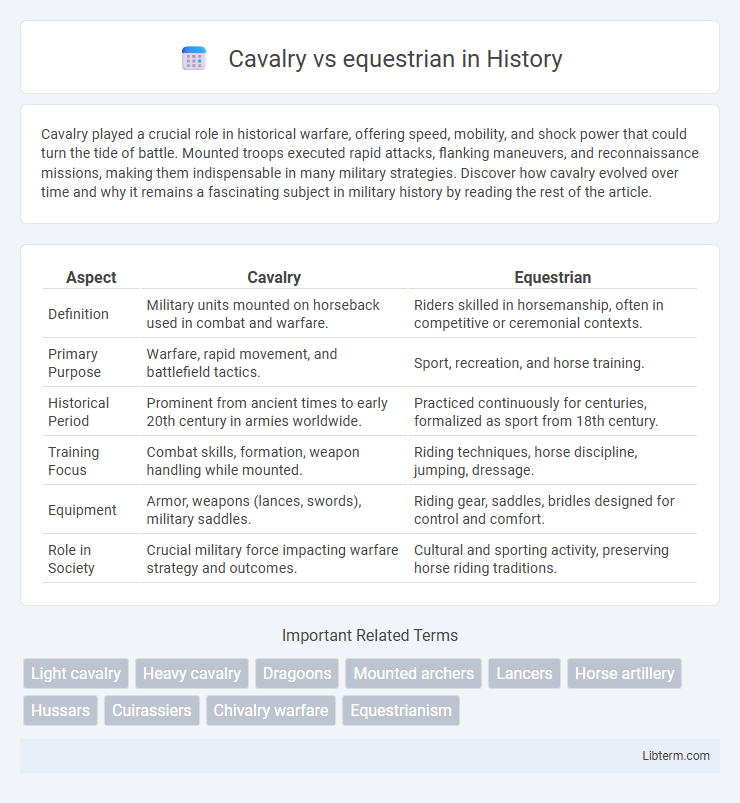Cavalry played a crucial role in historical warfare, offering speed, mobility, and shock power that could turn the tide of battle. Mounted troops executed rapid attacks, flanking maneuvers, and reconnaissance missions, making them indispensable in many military strategies. Discover how cavalry evolved over time and why it remains a fascinating subject in military history by reading the rest of the article.
Table of Comparison
| Aspect | Cavalry | Equestrian |
|---|---|---|
| Definition | Military units mounted on horseback used in combat and warfare. | Riders skilled in horsemanship, often in competitive or ceremonial contexts. |
| Primary Purpose | Warfare, rapid movement, and battlefield tactics. | Sport, recreation, and horse training. |
| Historical Period | Prominent from ancient times to early 20th century in armies worldwide. | Practiced continuously for centuries, formalized as sport from 18th century. |
| Training Focus | Combat skills, formation, weapon handling while mounted. | Riding techniques, horse discipline, jumping, dressage. |
| Equipment | Armor, weapons (lances, swords), military saddles. | Riding gear, saddles, bridles designed for control and comfort. |
| Role in Society | Crucial military force impacting warfare strategy and outcomes. | Cultural and sporting activity, preserving horse riding traditions. |
Overview: Cavalry vs Equestrian
Cavalry refers to military units trained to fight on horseback, emphasizing combat tactics, mobility, and strategic deployments in warfare. Equestrian pertains to horse riding as a sport, recreation, or skill, focusing on disciplines such as dressage, show jumping, and eventing rather than combat. The distinction lies in cavalry's battlefield role compared to equestrian's focus on horsemanship and competition.
Defining Cavalry: Historical Military Role
Cavalry refers to soldiers historically trained to fight on horseback, playing a crucial role in military tactics and battlefield mobility from ancient times through the early modern period. Cavalry units were essential for scouting, flanking maneuvers, and rapid attacks, often equipped with sabers, lances, or firearms adapted for mounted combat. Their strategic importance declined with the advent of mechanized warfare but remains a key concept in military history.
Understanding Equestrian: Broad Concepts
Equestrian encompasses a broad range of horse-related activities including riding, training, and horse care, extending beyond military applications to sports and recreation. It covers disciplines such as dressage, show jumping, and eventing, emphasizing skill, control, and partnership between horse and rider. Unlike cavalry, which specifically refers to mounted military forces, equestrian focuses on the cultural, competitive, and leisure aspects of horsemanship.
Key Differences Between Cavalry and Equestrian
Cavalry refers to military units historically trained for combat on horseback, emphasizing tactics, strategic mobility, and warfare roles. Equestrian pertains to the broader domain of horse riding as a sport, hobby, or skill, encompassing disciplines like dressage, show jumping, and eventing. The key difference lies in purpose: cavalry is focused on combat effectiveness, while equestrian centers on horsemanship, training, and recreational or competitive riding.
Historical Origins of Cavalry Forces
Cavalry forces originated as specialized military units trained for speed and mobility, emerging prominently in ancient Mesopotamia and Central Asia around 2000 BCE. Unlike equestrian activities, which primarily involve horseback riding for sport or leisure, cavalry was designed for tactical combat roles including reconnaissance, flanking, and shock attacks. The evolution of cavalry was pivotal in shaping battlefield strategies across civilizations such as the Romans, Mongols, and medieval European kingdoms.
Evolution of Equestrian Activities
Cavalry, historically a military unit mounted on horseback, evolved from ancient warfare tactics into specialized equestrian disciplines such as dressage and show jumping, reflecting a shift from combat to sport and recreation. Equestrian activities have expanded significantly, incorporating disciplines like endurance riding and eventing, which emphasize the partnership and skill between horse and rider beyond battlefield utility. This evolution highlights the transformation of mounted skills into diverse competitive sports, preserving horsemanship traditions within a modern context.
Cavalry Tactics and Combat Strategies
Cavalry tactics emphasize rapid movement, shock impact, and flanking maneuvers to disrupt enemy formations and exploit weak points on the battlefield. Mounted soldiers utilize coordinated charges, skirmishing, and feigned retreats to maximize mobility and create battlefield advantages. Effective cavalry combat strategies integrate reconnaissance, communication, and terrain exploitation to maintain superiority over infantry and opposing cavalry forces.
Modern Equestrian Disciplines and Sports
Modern equestrian disciplines encompass a wide range of sports such as show jumping, dressage, and eventing, emphasizing precision, skill, and horse-rider communication rather than combat tactics typical of historical cavalry units. Equestrian sports prioritize athletic performance, training, and competition under standardized rules governed by organizations like the Federation Equestre Internationale (FEI). While cavalry historically involved mounted soldiers in warfare, today's equestrian disciplines focus on sport, recreation, and horsemanship expertise.
Cultural Impact of Cavalry and Equestrianism
Cavalry has shaped military strategies and cultural identities across civilizations, symbolizing power and nobility through its historical role in warfare from ancient to modern times. Equestrianism, rooted in both sport and tradition, influences cultural heritage by preserving horsemanship skills, promoting competitive disciplines like dressage and show jumping, and fostering connections between humans and horses. Both cavalry and equestrian practices have left enduring legacies, impacting art, literature, and social customs worldwide.
Cavalry Legacy vs Equestrian Future
The Cavalry legacy embodies a rich tradition of mounted warfare, emphasizing strategic combat tactics and historical significance in shaping military outcomes. Equestrian pursuits reflect the future, prioritizing sport, recreation, and the biomechanics of horse-rider synergy to enhance performance and welfare. Advancements in equestrian technology and training methods signify an evolution from cavalry origins towards innovative horsemanship disciplines.
Cavalry Infographic

 libterm.com
libterm.com